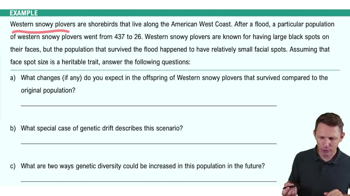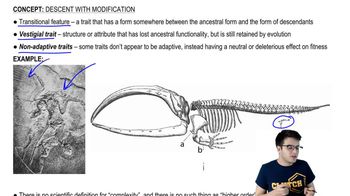Table of contents
- 1. Introduction to Biology2h 42m
- 2. Chemistry3h 40m
- 3. Water1h 26m
- 4. Biomolecules2h 23m
- 5. Cell Components2h 26m
- 6. The Membrane2h 31m
- 7. Energy and Metabolism2h 0m
- 8. Respiration2h 40m
- 9. Photosynthesis2h 49m
- 10. Cell Signaling59m
- 11. Cell Division2h 47m
- 12. Meiosis2h 0m
- 13. Mendelian Genetics4h 44m
- Introduction to Mendel's Experiments7m
- Genotype vs. Phenotype17m
- Punnett Squares13m
- Mendel's Experiments26m
- Mendel's Laws18m
- Monohybrid Crosses19m
- Test Crosses14m
- Dihybrid Crosses20m
- Punnett Square Probability26m
- Incomplete Dominance vs. Codominance20m
- Epistasis7m
- Non-Mendelian Genetics12m
- Pedigrees6m
- Autosomal Inheritance21m
- Sex-Linked Inheritance43m
- X-Inactivation9m
- 14. DNA Synthesis2h 27m
- 15. Gene Expression3h 20m
- 16. Regulation of Expression3h 31m
- Introduction to Regulation of Gene Expression13m
- Prokaryotic Gene Regulation via Operons27m
- The Lac Operon21m
- Glucose's Impact on Lac Operon25m
- The Trp Operon20m
- Review of the Lac Operon & Trp Operon11m
- Introduction to Eukaryotic Gene Regulation9m
- Eukaryotic Chromatin Modifications16m
- Eukaryotic Transcriptional Control22m
- Eukaryotic Post-Transcriptional Regulation28m
- Eukaryotic Post-Translational Regulation13m
- 17. Viruses37m
- 18. Biotechnology2h 58m
- 19. Genomics17m
- 20. Development1h 5m
- 21. Evolution3h 1m
- 22. Evolution of Populations3h 52m
- 23. Speciation1h 37m
- 24. History of Life on Earth2h 6m
- 25. Phylogeny2h 31m
- 26. Prokaryotes4h 59m
- 27. Protists1h 12m
- 28. Plants1h 22m
- 29. Fungi36m
- 30. Overview of Animals34m
- 31. Invertebrates1h 2m
- 32. Vertebrates50m
- 33. Plant Anatomy1h 3m
- 34. Vascular Plant Transport1h 2m
- 35. Soil37m
- 36. Plant Reproduction47m
- 37. Plant Sensation and Response1h 9m
- 38. Animal Form and Function1h 19m
- 39. Digestive System1h 10m
- 40. Circulatory System1h 57m
- 41. Immune System1h 12m
- 42. Osmoregulation and Excretion50m
- 43. Endocrine System1h 4m
- 44. Animal Reproduction1h 2m
- 45. Nervous System1h 55m
- 46. Sensory Systems46m
- 47. Muscle Systems23m
- 48. Ecology3h 11m
- Introduction to Ecology20m
- Biogeography14m
- Earth's Climate Patterns50m
- Introduction to Terrestrial Biomes10m
- Terrestrial Biomes: Near Equator13m
- Terrestrial Biomes: Temperate Regions10m
- Terrestrial Biomes: Northern Regions15m
- Introduction to Aquatic Biomes27m
- Freshwater Aquatic Biomes14m
- Marine Aquatic Biomes13m
- 49. Animal Behavior28m
- 50. Population Ecology3h 41m
- Introduction to Population Ecology28m
- Population Sampling Methods23m
- Life History12m
- Population Demography17m
- Factors Limiting Population Growth14m
- Introduction to Population Growth Models22m
- Linear Population Growth6m
- Exponential Population Growth29m
- Logistic Population Growth32m
- r/K Selection10m
- The Human Population22m
- 51. Community Ecology2h 46m
- Introduction to Community Ecology2m
- Introduction to Community Interactions9m
- Community Interactions: Competition (-/-)38m
- Community Interactions: Exploitation (+/-)23m
- Community Interactions: Mutualism (+/+) & Commensalism (+/0)9m
- Community Structure35m
- Community Dynamics26m
- Geographic Impact on Communities21m
- 52. Ecosystems2h 36m
- 53. Conservation Biology24m
21. Evolution
Introduction to Evolution and Natural Selection
Problem 12`
Textbook Question
What is an evolutionary adaptation?
a. A trait that improves the fitness of its bearer, compared with individuals without the trait
b. A trait that changes in response to environmental influences within the individual's lifetime
c. The ability of an individual to adjust to its environment
d. A trait that an individual wants so that it can survive
 Verified step by step guidance
Verified step by step guidance1
Understand the concept of evolutionary adaptation: It refers to a heritable trait that increases the fitness of an organism, meaning it enhances the organism's ability to survive and reproduce in its environment.
Consider the context of the problem: The beach-dwelling mice have developed white fur, which is a heritable trait. This trait likely provides a survival advantage by helping them blend into their sandy environment, thus avoiding predators.
Evaluate each option: a) A trait that improves the fitness of its bearer, compared with individuals without the trait, aligns with the definition of an evolutionary adaptation. b) A trait that changes in response to environmental influences within the individual's lifetime is more akin to acclimatization, not adaptation. c) The ability of an individual to adjust to its environment describes phenotypic plasticity, not a genetic adaptation. d) A trait that an individual wants so that it can survive is not a scientific explanation for adaptation.
Identify the correct option: Based on the definition and context, option a) is the correct description of an evolutionary adaptation.
Conclude with the understanding that evolutionary adaptations are traits that have been naturally selected because they confer a survival or reproductive advantage in a specific environment.
 Verified video answer for a similar problem:
Verified video answer for a similar problem:This video solution was recommended by our tutors as helpful for the problem above
Video duration:
2mPlay a video:
Was this helpful?
Key Concepts
Here are the essential concepts you must grasp in order to answer the question correctly.
Evolutionary Adaptation
An evolutionary adaptation is a heritable trait that enhances the fitness of an organism, allowing it to survive and reproduce more effectively in its environment. This trait is developed over generations through natural selection, where advantageous traits become more common in a population. In the context of the mice, the white fur is an adaptation that helps them blend into the sandy environment, reducing predation.
Recommended video:

Adaptive Radiation
Natural Selection
Natural selection is the process by which organisms with traits better suited to their environment tend to survive and reproduce at higher rates than others. This mechanism drives the evolution of species, as advantageous traits become more prevalent over generations. In the case of the Florida mice, natural selection favors those with fur color that provides camouflage, enhancing their survival against predators.
Recommended video:

Natural Selection
Genetic Heritability
Genetic heritability refers to the proportion of variation in a trait that can be attributed to genetic differences among individuals in a population. Traits like fur color in mice are passed down from parents to offspring through genes, such as MC1R, which influence pigmentation. Heritability ensures that beneficial adaptations, like the white fur of beach-dwelling mice, are transmitted across generations.
Recommended video:

Genetic Drift Example 2

 4:58m
4:58mWatch next
Master Evolution and Natural Selection with a bite sized video explanation from Jason
Start learningRelated Videos
Related Practice
































